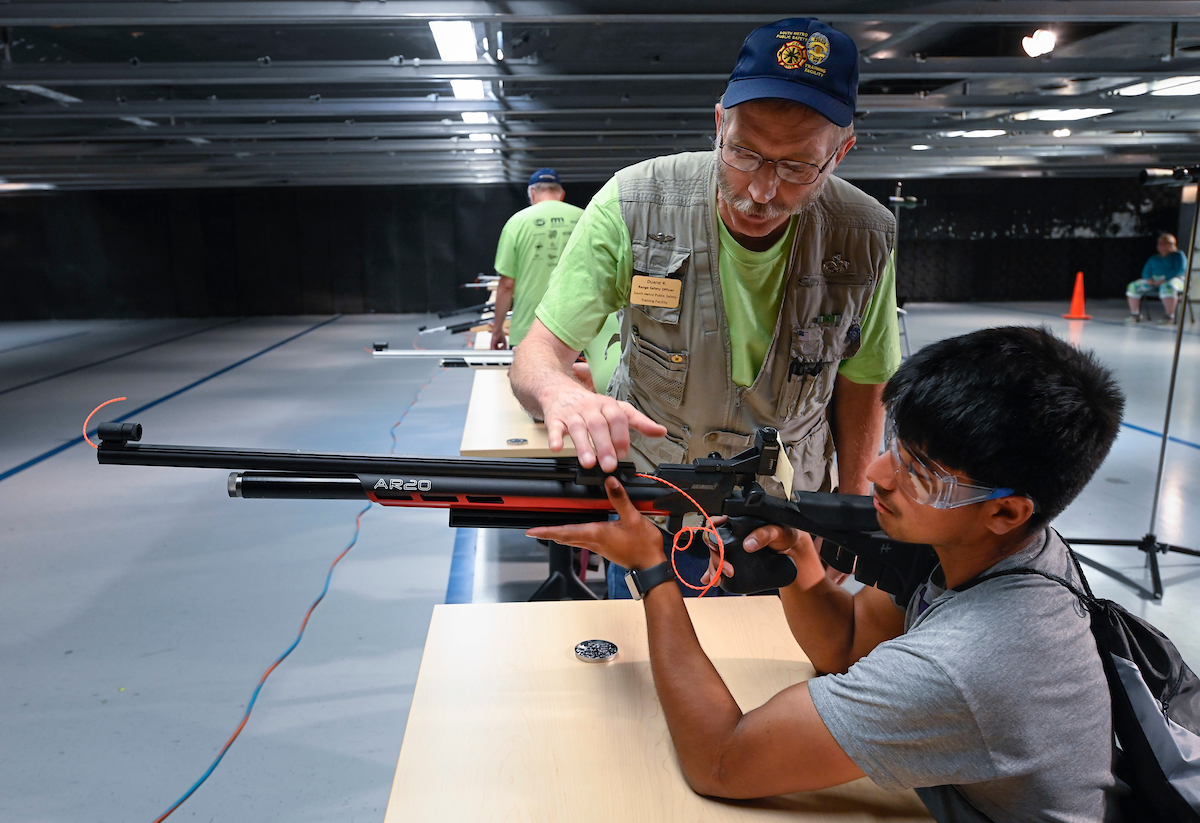
Adaptive Shooting
About
Adaptive Shooting has been part of the Paralympic Games since Toronto, Canada in 1976 and currently is being practiced in over 75 countries. Air Rifle and Pistol shooting is a test of skill and mental discipline, in which competitors use pneumatic rifles and pistols to fire a series of shots at a paper target. Competitions at the Paralympic Games are open to athletes with the following physical impairments: impaired muscle power, limb deficiency, hypertonia, ataxia, athetosis, and/or impaired passive range of movement.
Internationally, athletes compete in rifle and pistol events from distances of 10, 25, and 50 meters in men’s, women’s and mixed competitions as well as in trap events. Currently, Move United offers competitions for 10 meter rifle and pistol. Adaptive shooting utilizes a functional classification system, which enables athletes from different impairment classes to compete together either individually or in teams. Following the modified rules of the International Shooting Sport Federation (ISSF), shooting sports are governed by the World Shooting Para Sport. The adaptive rules take into account the differences that exist between competitive shooting for the able-bodied and competitive shooting for athletes with physical impairments.
Equipment
Rifles and Pistols: Competitors use .177 caliber rifles and pistols that use compressed gas (air or CO2) to propel the pellet towards the target when the trigger is depressed. Each match grade rifle or pistol is designed to be customized for the individual shooter, providing multiple adjustments for comfort and balance. Although there are many types of air guns available, usually spring activated or single pump models are used for hunting and produce too much pellet velocity to be allowed in competitions where velocities are usually limited to less than 600 feet per second (fps). Consistent velocity is critical to air gun accuracy and pellet velocities can vary, depending on the type of air gun used. Precision match grade pre-charged pneumatic (PCP) air guns deliver the most consistent muzzle velocity and usually produce muzzle velocities between 550 feet per second (fps) to 580 fps. PCP air guns utilize a refillable, pressurized canister to deliver several hundred consistent shots. Consistent velocity is important when aiming at a 10 ring the size of a pin head (1mm).
Pellets: Air Rifles or Air Pistols use lead pellets that are somewhat “hour-glassed” shaped with a diameter of 4.5 mm or are .177 of an inch and weigh between 7 and 9 grains. There are a wide variety of pellets offered by manufacturers. The quality of the pellets is determined by the consistency of shape and weight of each pellet.
Accessories: There is a wide range of shooting equipment designed to improve the shooter’s performance. From shooting jackets, gloves, tables, rests, etc., most accessories are designed to increase a shooter’s stability, improve accuracy and reduce fatigue during competitions.
Click here for the NRA adaptive shooting equipment suppliers.
Competition Rules and Classifications
Rulebooks
- 2025 Move United Shooting Rulebook
- World Shooting Para Sport Rules
- International Shooting Sport Federation Rules
Air Rifle and Pistol Classifications
-
SH1 (Pistol): This sport class is designated for athletes with upper and/or lower limb impairment for competition in Pistol events.
-
SH1 (Rifle): This sport class is designated to athletes with lower limb impairment for competition in Rifle events. Generally, these competitors have the physical ability to support the weight of the rifle or pistol unassisted.
-
SH2 (Rifle): This sport class is for rifle events only, and is designated to athletes with upper limb impairment (which necessitates them to use a shooting stand to support the rifle), all or not in combination with lower limb impairment. SH2 shooters unable to load pellets into their air rifle, are allowed to have assistants who load the rifle for them before each shot.
-
SH-VI (Rifle): This sport class is designated to athletes with a vision impairment for competition in Rifle events. Athletes may utilize the ECO-AIMS or VIASS audible tone targeting system. Athletes may use a sling to support the rifle.
Trap Shooting
- SG-S (Trap): Athletes with poor balance and/or trunk stability, competing from a wheelchair in a standard seated position. Athletes have an impairment in the lower limb(s), but no functional limitation in the upper limbs.
- SG-L (Trap): Athletes with good balance and trunk function, competing from a standing position. Athletes have an impairment in the lower limb(s), but no functional limitation in the upper limbs.
- SG-U (Trap): Athletes with good balance and trunk function, competing from a standing position. Athletes have an impairment in the non-shooting arm.
Learn More
Air Pistol and Air Rifle
Refer to the WSPS rules for details on positions
Qualification Round:
- Air Rifle SH1 and VI Prone: 50 minutes (electronic targets); 60 minutes (paper targets)
- Air Rifle SH2 Prone: 60 minutes (electronic targets); 70 minutes (paper targets)
Elimination Round:
- Eight finalists shoot 2, 3 shot series in 150 seconds each
- 14 single shots are each fired on command with 50 seconds for each shot
- Single eliminations start after the second single shot (first six shots in three shot series, then the next 2 single shots fired on command)
- Shooters are eliminated one by one, after every two single shots, until the gold and silver medalists from each division are decided
- Ties between gold and silver are determined by single shots until a winner is determined
Programs Near You
Ready to try adaptive shooting? Click here for locations near you!


